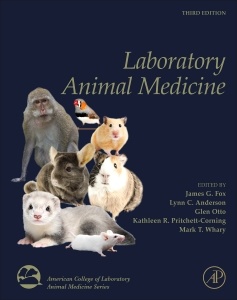Description
Laboratory Animal Medicine (3rd Ed.)
American College of Laboratory Animal Medicine Series
Coordinators: Anderson Lynn C., Otto Glen, Pritchett-Corning Kathleen R., Whary Mark T.
Editor-in-Chief: Fox James G.
Language: English
Subjects for Laboratory Animal Medicine:
1708 p. · 21.5x27.6 cm · Hardback
Description
/li>Contents
/li>Readership
/li>Biography
/li>Comment
/li>
Laboratory Animal Medicine, Third Edition, is a fully revised publication from the American College of Laboratory Medicine’s acclaimed blue book series. It presents an up-to-date volume that offers the most thorough coverage of the biology, health, and care of laboratory animals.
The book is organized by species, with new inclusions of chinchillas, birds, and program and employee management, and is written and edited by known experts in the fields.
Users will find gold-standard guidance on the study of laboratory animal science, as well as valuable information that applies across all of the biological and biomedical sciences that work with animals.
- Organized by species for in-depth understanding of biology, health, and best care of animals
- Features the inclusion of chinchillas, quail, and zebra finches as animal models
- Offers guidance on program and employee management
- Covers regulations, policies, and laws for laboratory animal management worldwide
1. Lab Animal Medicine: Historical Perspectives 2. Laws, Regulations, and Policies Affecting the Use of Laboratory Animals 3. Biology and Diseases of Mice 4. Biology and Diseases of Rats 5. Biology and Diseases of Hamsters 6. Biology and Diseases of Guinea Pigs 7. Biology and Diseases of Other Rodents 8. Biology and Diseases of Woodchucks 9. Biology and Diseases of Chinchillas 10. Biology and Diseases of Rabbits 11. Microbiological Quality Control for Laboratory Rodents and Lagomorphs 12. Biology and Diseases of Dogs 13. Biology and Diseases of Cats 14. Biology and Diseases of Ferrets 15. Biology and Diseases of Ruminants: Sheep, Goats, and Cattle 16. Biology and Diseases of Swine 17. Biology and Diseases of Nonhuman Primates 18. Biology and Diseases of Amphibians 19. Biology and Diseases of Reptiles 20. Biology and Management of the Zebrafish 21. Biology and Management of Laboratory Fishes 22. Quails in Biomedical Research 23. Zebra Finches in Biomedical Research 24. Preanesthesia, Anesthesia, Analgesia, and Euthanasia 25. Techniques of Experimentation 26. Gnotobiotics 27. Working Safely with Experimental Animals Exposed to Biohazards 28. Selected Zoonoses 29. Xenozoonoses: The Risk of Infection after Xenotransplantation 30. Occupational Health of Laboratory Animal Personnel 31. Genetic Monitoring of Laboratory Mice and Rats 32. Genetically Modified Animals 33. Factors That Can Influence Animal Research 34. Animal Models in Biomedical Research 35. Research in Laboratory Animals and Comparative Medicine 36. Design and Management of Animal Facilities 37. Program and Employee Management 38. Laboratory Animal Behavior 39. Laboratory Animal Welfare
- Organized by species for in-depth understanding of biology, health, and best care of animals
- Features the inclusion of chinchillas, quail, and zebra finches as animal models
- Offers guidance on program and employee management
- Covers regulations, policies, and laws for laboratory animal management worldwide




